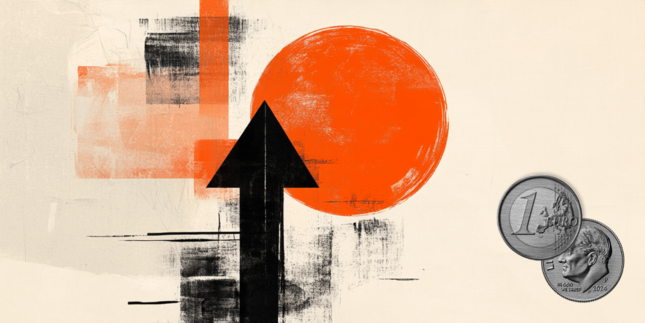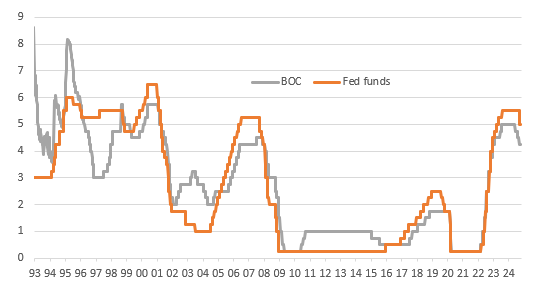A fourth consecutive Bank of Canada rate cut is expected, but the market senses it will accelerate the move towards neutral policy rates with a 50bp step change. Inflation is finally below target and unemployment is trending higher, but the economy is still growing. We narrowly favour the BoC sticking with 25bp increments, but would not be shocked by 50bp.
Close call between 25bp and 50bp
The Bank of Canada has lowered the target for the overnight rate at its past three policy meetings and is expected to follow up with a fourth consecutive cut next week. The question is, will it be another 25bp move or will the bank follow the Federal Reserve’s lead and cut by 50bp?
Consumer price inflation slowed to just 1.6% year-on-year in September, undershooting the 2% target for the first time since February 2021. The bulk of the residual strength is due to housing costs, which if excluded would prompt inflation to fall below 1%. Nonetheless, we can’t pick and choose which things to exclude and include, and BoC officials remain wary about easing too far, too fast and running the risk of a return of price pressures.
At the September policy meeting, the committee argued that “excess supply in the economy continues to put downward pressure on inflation, while price increases in shelter and some other services are holding inflation up. The Governing Council is carefully assessing these opposing forces on inflation".
Canada unemployment rate (%) versus consumer price inflation (YoY%)
Source: Macrobond, ING
Inflation is cooling, the labour market is loosening, but the growth outlook is improving
In terms of the job market situation, unemployment has climbed from a low of 4.8% in July 2022 to 6.5% today, but this is not because of job losses. Total employment is actually at all-time highs and stands more than a million higher than pre-pandemic levels. Instead, it is down to excess supply resulting from rapid population increase generated by a large wave of immigration in recent years. Nonetheless, this slack in the labour market should keep a lid on wage pressures and help contain inflation pressures over the medium term.
General activity levels are subdued, but the economy is growing with recent monthly GDP and retail sales numbers beating expectations and the third-quarter Business Outlook survey pointing to a more optimistic outlook for the Canadian economy. As such, we continue to see a strong case for ongoing gradual rate cuts to bring monetary policy to a more neutral setting. Whether the committee sees enough to justify an acceleration in the process with a 50bp move is a close call.
US versus Canada policy rates (%)
Source: Macrobond, ING
Widening US-Canada rate differentials could argue for caution
The consensus is on a knife edge as to whether it will be a 25bp or a 50bp cut. Financial markets are more confident, pricing 45bp of a 50bp move with a cumulative 83bp of cuts priced over the November and December meetings versus a mere 60bp just over a week ago.
A 50bp cut from the BoC would widen out the spread with the Fed funds target rate to 125bp once again and this may put additional downside pressures on the Canadian dollar. This would threaten to push up import costs and may also add to nervousness from some officials about pursuing such a move. Consequently, we very narrowly favour the BoC choosing to go with 25bp, but would not be shocked by a 50bp cut.
CAD: Lots of dovishness in the price
The gap between the USD and CAD two-year swap rate has widened substantially of late, from 50bp to 80bp since the start of October. This is mirroring both aggressive dovish rate expectations in Canada and a hawkish repricing in the US. Such a widening gap has been the main driver for the USD/CAD rally to the 1.38 mark and has prevented the loonie from benefitting from its lower risk profile in the crosses, ahead of some pre-US election positioning.
The balance of risks is clearly skewed to the upside for CAD next week. Markets are fully pricing in a 50bp move that is far from guaranteed, and a 25bp cut can trigger a sizeable correction higher in the loonie. Even in the event of a half-point cut, markets are pricing in more than 25bp in December, meaning the room for a further dovish repricing in the CAD OIS curve is low. Our view remains that CAD has room to appreciate, if not against USD that might get support into the US election, at least versus other commodity currencies (e.g. AUD, NZD) that are more exposed to Trump hedges.
Read the original analysis: Canada debates whether to supersize rate cuts
Content disclaimer: This publication has been prepared by ING solely for information purposes irrespective of a particular user's means, financial situation or investment objectives. The information does not constitute investment recommendation, and nor is it investment, legal or tax advice or an offer or solicitation to purchase or sell any financial instrument. Read more here: https://think.ing.com/content-disclaimer/
Recommended Content
Editors’ Picks

EUR/USD trades with sizeable gains above 1.1500, at over three-year highs
EUR/USD trades over 1% higher so far this Monday as the relentless selling interest in the US Dollar keeps it well above the 1.1500 threshold - the highest level since November 2021. Growing concerns over a US economic recession and the Federal Reserve’s autonomy continue to exert downward pressure on the USD.

Gold stands tall on concerns over trade war, Fed’s independence
Gold price closes on $3,400 as the record rally regains strength on Easter Monday. Concerns over US-China trade war escalation and the Fed’s independence smash the US Dollar to three-year troughs. RSI stays overbought on the daily chart, with thin volumes likely to exaggerate moves in Gold price.

GBP/USD stays strongly bid near 1.3400 on intense US Dollar weakness
GBP/USD continues its winning streak that began on April 8, trading close to 1.3400 in early Europe on Monday. The extended US Dollar weakness, amid US-Sino trade war-led recession fears and heightened threat to the Fed's independence, continue to underpin the pair. Thin trading is set to extend.

Bitcoin finally breaks out, Ethereum and Ripple could follow
Bitcoin's price broke above its key resistance level after facing multiple rejections around it the previous week. Ethereum and Ripple prices are approaching their key resistance levels; a breakout could signal a rally ahead.

Future-proofing portfolios: A playbook for tariff and recession risks
It does seem like we will be talking tariffs for a while. And if tariffs stay — in some shape or form — even after negotiations, we’ll likely be talking about recession too. Higher input costs, persistent inflation, and tighter monetary policy are already weighing on global growth.

The Best brokers to trade EUR/USD
SPONSORED Discover the top brokers for trading EUR/USD in 2025. Our list features brokers with competitive spreads, fast execution, and powerful platforms. Whether you're a beginner or an expert, find the right partner to navigate the dynamic Forex market.

